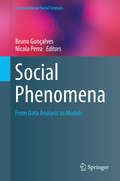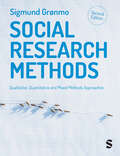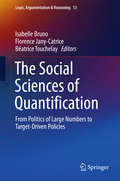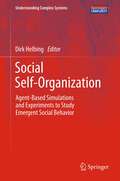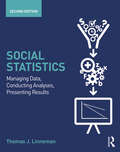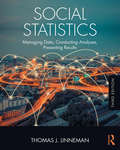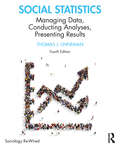- Table View
- List View
Social Networks and the Economics of Sports
by Panos M. Pardalos Victor ZamaraevThis book presents recent research developments in social networks, economics, management, marketing and optimization applied to sports. The volume will be of interest to students, researchers, managers from sports, policy makers and as well athletes. In particular the book contains research papers and reviews addressing the following issues: social network tools for player selection, movement and pricing in team sports, methods for ranking teams and evaluating players' performance, economics and marketing issues related to sports clubs, techniques for predicting outcomes of sports competitions, optimal strategies in sports, scheduling and managing sports tournaments, optimal referee assignment techniques and the economics and marketing of sports entertainment.
Social Networks and their Economics: Influencing Consumer Choice
by Daniel BirkeReveals how consumer choice can be better understood and influenced using social networks analysis (SNA) Intuitively, we all appreciate that we can be influenced by our friends and peers in what we do, how we behave, and what products we consume. Until recently, it has been difficult to measure this interdependence, mainly because data on social networks was difficult to collect and not readily available. More and more companies such as mobile phone carriers or social networking sites such as Facebook are collecting such data electronically. Daniel Birke illustrates in compelling real-world case studies how companies use social networks for marketing purposes and which statistical analysis and unique datasets can be used. Social Networks and their Economics: Explores network effects and the analysis of social networks, whilst providing an overview of the state-of-the art research. Looks at consumption interdependences between friends and peers: Who is influencing who through which channels and to what degree? Presents statistical methods and research techniques that can be used in the analysis of social networks. Examines SNA and its practical application for marketing purposes. Features a supporting website www.wiley.com/go/social_networks featuring SNA visualizations and business case studies. Aimed at post-graduate students involved in social network analysis, industrial economics, innovation and consumer marketing, this book offers a unique perspective from both an academic and practitioner point of view on how social networks can help understand and influence consumer behaviour. This book will prove to be a useful resource for marketing practitioners from companies where social network data is available and for consulting companies who advise businesses on marketing and social media related issues.
Social Networks and their Economics: Influencing Consumer Choice
by Daniel BirkeReveals how consumer choice can be better understood and influenced using social networks analysis (SNA) Intuitively, we all appreciate that we can be influenced by our friends and peers in what we do, how we behave, and what products we consume. Until recently, it has been difficult to measure this interdependence, mainly because data on social networks was difficult to collect and not readily available. More and more companies such as mobile phone carriers or social networking sites such as Facebook are collecting such data electronically. Daniel Birke illustrates in compelling real-world case studies how companies use social networks for marketing purposes and which statistical analysis and unique datasets can be used. Social Networks and their Economics: Explores network effects and the analysis of social networks, whilst providing an overview of the state-of-the art research. Looks at consumption interdependences between friends and peers: Who is influencing who through which channels and to what degree? Presents statistical methods and research techniques that can be used in the analysis of social networks. Examines SNA and its practical application for marketing purposes. Features a supporting website www.wiley.com/go/social_networks featuring SNA visualizations and business case studies. Aimed at post-graduate students involved in social network analysis, industrial economics, innovation and consumer marketing, this book offers a unique perspective from both an academic and practitioner point of view on how social networks can help understand and influence consumer behaviour. This book will prove to be a useful resource for marketing practitioners from companies where social network data is available and for consulting companies who advise businesses on marketing and social media related issues.
Social Networks with Rich Edge Semantics (Chapman & Hall/CRC Data Mining and Knowledge Discovery Series)
by Quan Zheng David SkillicornSocial Networks with Rich Edge Semantics introduces a new mechanism for representing social networks in which pairwise relationships can be drawn from a range of realistic possibilities, including different types of relationships, different strengths in the directions of a pair, positive and negative relationships, and relationships whose intensities change with time. For each possibility, the book shows how to model the social network using spectral embedding. It also shows how to compose the techniques so that multiple edge semantics can be modeled together, and the modeling techniques are then applied to a range of datasets. Features Introduces the reader to difficulties with current social network analysis, and the need for richer representations of relationships among nodes, including accounting for intensity, direction, type, positive/negative, and changing intensities over time Presents a novel mechanism to allow social networks with qualitatively different kinds of relationships to be described and analyzed Includes extensions to the important technique of spectral embedding, shows that they are mathematically well motivated and proves that their results are appropriate Shows how to exploit embeddings to understand structures within social networks, including subgroups, positional significance, link or edge prediction, consistency of role in different contexts, and net flow of properties through a node Illustrates the use of the approach for real-world problems for online social networks, criminal and drug smuggling networks, and networks where the nodes are themselves groups Suitable for researchers and students in social network research, data science, statistical learning, and related areas, this book will help to provide a deeper understanding of real-world social networks.
Social Networks with Rich Edge Semantics (Chapman & Hall/CRC Data Mining and Knowledge Discovery Series)
by Quan Zheng David SkillicornSocial Networks with Rich Edge Semantics introduces a new mechanism for representing social networks in which pairwise relationships can be drawn from a range of realistic possibilities, including different types of relationships, different strengths in the directions of a pair, positive and negative relationships, and relationships whose intensities change with time. For each possibility, the book shows how to model the social network using spectral embedding. It also shows how to compose the techniques so that multiple edge semantics can be modeled together, and the modeling techniques are then applied to a range of datasets. Features Introduces the reader to difficulties with current social network analysis, and the need for richer representations of relationships among nodes, including accounting for intensity, direction, type, positive/negative, and changing intensities over time Presents a novel mechanism to allow social networks with qualitatively different kinds of relationships to be described and analyzed Includes extensions to the important technique of spectral embedding, shows that they are mathematically well motivated and proves that their results are appropriate Shows how to exploit embeddings to understand structures within social networks, including subgroups, positional significance, link or edge prediction, consistency of role in different contexts, and net flow of properties through a node Illustrates the use of the approach for real-world problems for online social networks, criminal and drug smuggling networks, and networks where the nodes are themselves groups Suitable for researchers and students in social network research, data science, statistical learning, and related areas, this book will help to provide a deeper understanding of real-world social networks.
Social Phenomena: From Data Analysis to Models (Computational Social Sciences)
by Bruno Gonçalves Nicola PerraThis book focuses on the new possibilities and approaches to social modeling currently being made possible by an unprecedented variety of datasets generated by our interactions with modern technologies. This area has witnessed a veritable explosion of activity over the last few years, yielding many interesting and useful results. Our aim is to provide an overview of the state of the art in this area of research, merging an extremely heterogeneous array of datasets and models. Social Phenomena: From Data Analysis to Models is divided into two parts. Part I deals with modeling social behavior under normal conditions: How we live, travel, collaborate and interact with each other in our daily lives. Part II deals with societal behavior under exceptional conditions: Protests, armed insurgencies, terrorist attacks, and reactions to infectious diseases. This book offers an overview of one of the most fertile emerging fields bringing together practitioners from scientific communities as diverse as social sciences, physics and computer science. We hope to not only provide an unifying framework to understand and characterize social phenomena, but also to help foster the dialogue between researchers working on similar problems from different fields and perspectives.
Social Policy Reform in Hong Kong and Shanghai: A Tale of Two Cities
by Linda Wong Lynn T. White, III Gui ShixunAs the richest cities in the world's most populous nation, Hong Kong and Shanghai have recently experienced dynamic growth spurred by more and better-managed capital. These cities also have social problems whose solutions will cost money. Their urban populations are aging. Health finance at the level these "First World" cities demand threatens to consume a large portion of the municipal budgets. Eldercare and social security are now less well covered by traditional Chinese families. Education has become more complex and public tuition, where it occurs, brings with it official plans for schools. Immigrants have flocked to Shanghai from inland China, and Hong Kong's border has become a protector of the former colony's high productivity jobs. Housing problems also have deeply affected both cities, albeit in somewhat different ways. This book provides a comprehensive overview of the similarities and differences between social policies in the two cities. Each chapter covers a different issue: health finance, housing, education, labor, poverty and social security, eldercare, and migration and competitiveness. The contributors explore pertinent developments in each city and analyze the similarities and differences between the two cities' approaches to social policies. They focus on policy reform and the interface between social policy and its environment. One main theme throughout the book is the extent to which spending for capital accumulation is in conflict with spending for social policies.
Social Policy Reform in Hong Kong and Shanghai: A Tale of Two Cities (Hong Kong Becoming China Ser.)
by Linda Wong Lynn T. White, III Gui ShixunAs the richest cities in the world's most populous nation, Hong Kong and Shanghai have recently experienced dynamic growth spurred by more and better-managed capital. These cities also have social problems whose solutions will cost money. Their urban populations are aging. Health finance at the level these "First World" cities demand threatens to consume a large portion of the municipal budgets. Eldercare and social security are now less well covered by traditional Chinese families. Education has become more complex and public tuition, where it occurs, brings with it official plans for schools. Immigrants have flocked to Shanghai from inland China, and Hong Kong's border has become a protector of the former colony's high productivity jobs. Housing problems also have deeply affected both cities, albeit in somewhat different ways. This book provides a comprehensive overview of the similarities and differences between social policies in the two cities. Each chapter covers a different issue: health finance, housing, education, labor, poverty and social security, eldercare, and migration and competitiveness. The contributors explore pertinent developments in each city and analyze the similarities and differences between the two cities' approaches to social policies. They focus on policy reform and the interface between social policy and its environment. One main theme throughout the book is the extent to which spending for capital accumulation is in conflict with spending for social policies.
The Social, Political and Historical Contours of Deportation (Immigrants and Minorities, Politics and Policy)
by Bridget Anderson, Matthew J. Gibney and Emanuela PaolettiIn recent years states across the world have boosted their legal and institutional capacity to deport noncitizens residing on their territory, including failed asylum seekers, “illegal” migrants, and convicted criminals. Scholars have analyzed this development primarily through the lens of immigration control. Deportation has been viewed as one amongst a range of measures designed to control entrance, distinguished primarily by the fact that it is exercised inside the territory of the state. But deportation also has broader social and political effects. It provides a powerful way through which the state reminds noncitizens that their presence in the polity is contingent upon acceptable behavior. Furthermore, in liberal democratic states immunity from deportation is one of the key privileges that citizens enjoy that distinguishes them from permanent residents. This book examines the historical, institutional and social dimensions of the relationship between deportation and citizenship in liberal democracies. Contributions also include analysis of the formal and informal functions of administrative immigration detention, and the role of the European Parliament in the area of irregular immigration and borders. The book also develops an analytical framework that identifies and critically appraises grassroots and sub national responses to migration policy in liberal democratic societies, and considers how groups form after deportation and the employment of citizenship in this particular context, making it of interest to scholars and international policy makers alike.“It is commonly surmised that the increased flows of goods, ideas, finance and people are slowly leading to the dissolution of boundaries between nation-states. However, as the varied and excellent chapters in this collection demonstrate, the enforcement of state power through detention and deportation is still a real and growing feature of contemporary political life. Expulsion has always been a moral sanction (think of Adam and Eve being banished from the Garden of Eden or the ostracism directed against dissidents in ancient Athens, who were forced to leave for ten years). As the editors suggest, deportation remains a means of enforcing a normative order (‘a community of values’), while the authors and editors of this book have expanded the subject-matter to include the deportees’ perspectives and the effects of deportation on families, other potential victims and on those whose social inclusion has been affirmed by the exclusion of others. These studies will enrich and enlarge the study of the more naked forms of state power.” - Robin Cohen, Professor Emeritus of Development Studies, University of Oxford“This wide-ranging, well-researched, and highly informative work is a major contribution to the growing body of scholarship examining the harsh consequences of deportation around the world. The editors have gathered an impressive group of scholars who craft an eclectic view of how deportation has evolved, what it may signify, and how it now works in various settings. With its inclusion of historical, institutional, comparative, and finely-textured, sensitive experiential studies, this book offers an important--if frequently distressing--overview of phenomena that deserve our full attention.” - Daniel Kanstroom, Professor of Law and Director, International Human Rights Program, Boston College Law School
Social Research Methods: Qualitative, Quantitative and Mixed Methods Approaches
by Sigmund GronmoFraming research as the process of asking and answering questions, this book demonstrates how to identify good research questions and how to structure and explore them successfully. Whether you are just beginning your research journey or are a seasoned traveller, it helps you: • Decide what you want to achieve with your research • Know what options you have to explore your goals • Navigate the nuances of different research approaches • Understand the decisions of other researchers • Choose what path best suits your project. Through real-life examples demonstrating different types of research, the book introduces qualitative, quantitative, and mixed methods approaches so you can compare different methods at every stage of the research process, from initial idea and design to data collection and analysis. This new edition includes new chapters on collecting and analysing mixed methods data, and additional content on qualitative data analysis. New examples reflect the cultural and global diversity of social research, and extra visual aids and summaries support understanding of key research concepts and stages. The book is accompanied by an online teaching guide, including videos, additional case studies, annotated articles, and critical thinking exercises.
Social Research Methods: Qualitative, Quantitative and Mixed Methods Approaches
by Sigmund GronmoFraming research as the process of asking and answering questions, this book demonstrates how to identify good research questions and how to structure and explore them successfully. Whether you are just beginning your research journey or are a seasoned traveller, it helps you: • Decide what you want to achieve with your research • Know what options you have to explore your goals • Navigate the nuances of different research approaches • Understand the decisions of other researchers • Choose what path best suits your project. Through real-life examples demonstrating different types of research, the book introduces qualitative, quantitative, and mixed methods approaches so you can compare different methods at every stage of the research process, from initial idea and design to data collection and analysis. This new edition includes new chapters on collecting and analysing mixed methods data, and additional content on qualitative data analysis. New examples reflect the cultural and global diversity of social research, and extra visual aids and summaries support understanding of key research concepts and stages. The book is accompanied by an online teaching guide, including videos, additional case studies, annotated articles, and critical thinking exercises.
Social Research Methods: Qualitative, Quantitative and Mixed Methods Approaches
by Sigmund GronmoFraming research as the process of asking and answering questions, this book demonstrates how to identify good research questions and how to structure and explore them successfully. Whether you are just beginning your research journey or are a seasoned traveller, it helps you: • Decide what you want to achieve with your research • Know what options you have to explore your goals • Navigate the nuances of different research approaches • Understand the decisions of other researchers • Choose what path best suits your project. Through real-life examples demonstrating different types of research, the book introduces qualitative, quantitative, and mixed methods approaches so you can compare different methods at every stage of the research process, from initial idea and design to data collection and analysis. This new edition includes new chapters on collecting and analysing mixed methods data, and additional content on qualitative data analysis. New examples reflect the cultural and global diversity of social research, and extra visual aids and summaries support understanding of key research concepts and stages. The book is accompanied by an online teaching guide, including videos, additional case studies, annotated articles, and critical thinking exercises.
Social Science Research in the Arab World and Beyond: A Guide for Students, Instructors and Researchers (SpringerBriefs in Sociology)
by Mark TesslerThis book presents and discusses the logic and method of social science research adapted mainly for instruction at Arab universities and for research in Arab countries, but with applicability beyond the region. It illustrates major concepts and methods pertaining to research with examples of previous studies carried out in the Arab world and with exercises using Arab Barometer and other datasets. The book situates itself between a regular methods textbook and an annotated list of major concepts and methods, and includes an introduction, three chapters, and four appendices.
The Social Sciences of Quantification: From Politics of Large Numbers to Target-Driven Policies (Logic, Argumentation & Reasoning #13)
This book details how quantification can serve both as evidence and as an instrument of government, whether when dealing with statistics on employment, occupational health and economic governance, or when developing public management or target-driven policies. In the process, it presents a thought-provoking homage to Alain Desrosières, who pioneered ways to study large numbers and the politics underlying them.It opens with a summary of Desrosières's contributions to the field in which several generations of researchers detail how this statistician and historian profoundly influenced them. This tribute, based on personal testimonies, bears witness to the vitality of the school of thought and analytical framework Desrosières initiated. Next, a collection of essays explores the statistical argument in the neoliberal era, examining issues such as counting the homeless in Europe, measuring the performance of public services, and quantifying the effects of public action on the unemployed in France.The third part details the uses of quantification. It reveals that although statistics are frequently used to the advantage of those in power, they can also play a vital role in challenging and resisting both the conventions underlying the measurements as well as the measurements themselves.Featuring the work of economists, historians, political scientists, sociologists, and statisticians, this title provides readers with a thoughtful look at an influential figure in the history of statistics. It also shows how statistics are used to direct public policy, the degree of conflict that is possible in their production, and the disputes that can develop around their uses.
Social Security, Household, and Family Dynamics in Ageing Societies (European Studies of Population #1)
by Jean-Pierre Gonnot Nico Keilman Christopher PrinzMany industrialized countries are facing large problems with their public pension systems in the 21st century. An unfavourable age distribution, with lower population shares in working ages and increasing shares and numbers of elderly persons in the future will lead, under current pension systems, to a drop in contributions and at the same time to sharply rising amounts of benefits paid. This book analyzes the impact of dynamics in age structure and marital status composition on future public pension expenditures in twelve industrialized countries. It shows that there is no demographic response to population ageing at the horizon 2030. Neither an increase in fertility nor an inflow of migrants can rejuvenate national populations, unless fertility and/or migration reach unrealistically high levels. Therefore, the overall conclusion of this book is that demographic variables are of limited help to relieve the burden of future public pension expenditures. Substantial reductions of the public pension burden have to be sought in socioeconomic measures, and not in adjusting demographic conditions. The book includes various demographic and pension scenarios for pension costs in the coming decades for Austria, Canada, the Czech and Slovak Republics, Finland, France, Germany, Hungary, Italy, the Netherlands, Norway, Poland, and Sweden. Not only old age pensions, but also disability and survivor pensions have been investigated. Variant projections were calculated for changes in demographic, labour force, and pension system variables. In addition, separate case studies for three countries deal with: a pension system in Austria in which benefits depend on the number children ever born; the impact of household dynamics on social security in the Netherlands, not just marriage and marriage dissolution; and with the consequences of economic growth for public pensions in Sweden.
Social Self-Organization: Agent-Based Simulations and Experiments to Study Emergent Social Behavior (Understanding Complex Systems)
by Dirk HelbingWhat are the principles that keep our society together? This question is even more difficult to answer than the long-standing question, what are the forces that keep our world together. However, the social challenges of humanity in the 21st century ranging from the financial crises to the impacts of globalization, require us to make fast progress in our understanding of how society works, and how our future can be managed in a resilient and sustainable way. This book can present only a few very first steps towards this ambitious goal. However, based on simple models of social interactions, one can already gain some surprising insights into the social, ``macro-level'' outcomes and dynamics that is implied by individual, ``micro-level'' interactions. Depending on the nature of these interactions, they may imply the spontaneous formation of social conventions or the birth of social cooperation, but also their sudden breakdown. This can end in deadly crowd disasters or tragedies of the commons (such as financial crises or environmental destruction). Furthermore, we demonstrate that classical modeling approaches (such as representative agent models) do not provide a sufficient understanding of the self-organization in social systems resulting from individual interactions. The consideration of randomness, spatial or network interdependencies, and nonlinear feedback effects turns out to be crucial to get fundamental insights into how social patterns and dynamics emerge. Given the explanation of sometimes counter-intuitive phenomena resulting from these features and their combination, our evolutionary modeling approach appears to be powerful and insightful. The chapters of this book range from a discussion of the modeling strategy for socio-economic systems over experimental issues up the right way of doing agent-based modeling. We furthermore discuss applications ranging from pedestrian and crowd dynamics over opinion formation, coordination, and cooperation up to conflict, and also address the response to information, issues of systemic risks in society and economics, and new approaches to manage complexity in socio-economic systems. Selected parts of this book had been previously published in peer reviewed journals.
Social Semantic Web Mining (Synthesis Lectures on Data, Semantics, and Knowledge)
by Tope Omitola Sebastián Ríos John BreslinThe past ten years have seen a rapid growth in the numbers of people signing up to use Web-based social networks (hundreds of millions of new members are now joining the main services each year) with a large amount of content being shared on these networks (tens of billions of content items are shared each month). With this growth in usage and data being generated, there are many opportunities to discover the knowledge that is often inherent but somewhat hidden in these networks. Web mining techniques are being used to derive this hidden knowledge. In addition, the Semantic Web, including the Linked Data initiative to connect previously disconnected datasets, is making it possible to connect data from across various social spaces through common representations and agreed upon terms for people, content items, etc. In this book, we detail some current research being carried out to semantically represent the implicit and explicit structures on the Social Web, along with the techniques being used to elicit relevant knowledge from these structures, and we present the mechanisms that can be used to intelligently mesh these semantic representations with intelligent knowledge discovery processes. We begin this book with an overview of the origins of the Web, and then show how web intelligence can be derived from a combination of web and Social Web mining. We give an overview of the Social and Semantic Webs, followed by a description of the combined Social Semantic Web (along with some of the possibilities it affords), and the various semantic representation formats for the data created in social networks and on social media sites. Provenance and provenance mining is an important aspect here, especially when data is combined from multiple services. We will expand on the subject of provenance and especially its importance in relation to social data. We will describe extensions to social semantic vocabularies specifically designed for community mining purposes (SIOCM). In the last three chapters, we describe how the combination of web intelligence and social semantic data can be used to derive knowledge from the Social Web, starting at the community level (macro), and then moving through group mining (meso) to user profile mining (micro).
Social Simulation for a Crisis: Results and Lessons from Simulating the COVID-19 Crisis (Computational Social Sciences)
by Frank DignumSimulating for a crisis is far more than creating a simulation of a crisis situation. In order for a simulation to be useful during a crisis, it should be created within the space of a few days to allow decision makers to use it as quickly as possible. Furthermore, during a crisis the aim is not to optimize just one factor, but to balance various, interdependent aspects of life. In the COVID-19 crisis, decisions had to be made concerning e.g. whether to close schools and restaurants, and the (economic) consequences of a 3 or 4-week lock-down had to be considered. As such, rather than one simulation focusing on a very limited aspect, a framework allowing the simulation of several different scenarios focusing on different aspects of the crisis was required. Moreover, the results of the simulations needed to be easily understandable and explainable: if a simulation indicates that closing schools has no effect, this can only be used if the decision makers can explain why this is the case. This book describes how a simulation framework was created for the COVID-19 crisis, and demonstrates how it was used to simulate a wide range of scenarios that were relevant for decision makers at the time. It also discusses the usefulness of the approach, and explains the decisions that had to be made along the way as well as the trade-offs. Lastly, the book examines the lessons learned and the directions for the further development of social simulation frameworks to make them better suited to crisis situations, and to foster a more resilient society.
Social Statistics: Managing Data, Conducting Analyses, Presenting Results (PDF)
by Thomas J. LinnemanMany fundamentally important decisions about our social life are a function of how well we understand and analyze DATA. This sounds so obvious but it is so misunderstood. Social statisticians struggle with this problem in their teaching constantly. This book and its approach is the ally and support of all instructors who want to accomplish this hugely important teaching goal. This innovative text for undergraduate social statistics courses is, (as one satisfied instructor put it), a "breath of fresh air. " It departs from convention by not covering some techniques and topics that have been in social stat textbooks for 30 years, but that are no longer used by social scientists today. It also includes techniques that conventional wisdom has previously thought to be the province of graduate level courses. Linneman#65533;s text is for those instructors looking for a thoroughly "modern" way to teach quantitative thinking, problem-solving, and statistical analysis to their students#65533;an undergraduate social statistics course that recognizes the increasing ubiquity of analytical tools in our data-driven age and therefore the practical benefit of learning how to "do statistics," to "present results" effectively (to employers as well as instructors), and to "interpret" intelligently the quantitative arguments made by others. A NOTE ABOUT THE AUTHOR#65533; At a recent Charter Day celebration, author Tom Linneman was awarded the Thomas Jefferson Teaching Award, the highest award given to young faculty members at the College of William and Mary. The citation for his award noted that Linneman has developed a reputation among his students as a demanding professor #65533; but one who genuinely cares about them.
Social Statistics: Managing Data, Conducting Analyses, Presenting Results
by Thomas J. LinnemanMany fundamentally important decisions about our social life are a function of how well we understand and analyze DATA. This sounds so obvious but it is so misunderstood. Social statisticians struggle with this problem in their teaching constantly. This book and its approach is the ally and support of all instructors who want to accomplish this hugely important teaching goal. This innovative text for undergraduate social statistics courses is, (as one satisfied instructor put it), a "breath of fresh air." It departs from convention by not covering some techniques and topics that have been in social stat textbooks for 30 years, but that are no longer used by social scientists today. It also includes techniques that conventional wisdom has previously thought to be the province of graduate level courses. Linneman’s text is for those instructors looking for a thoroughly "modern" way to teach quantitative thinking, problem-solving, and statistical analysis to their students…an undergraduate social statistics course that recognizes the increasing ubiquity of analytical tools in our data-driven age and therefore the practical benefit of learning how to "do statistics," to "present results" effectively (to employers as well as instructors), and to "interpret" intelligently the quantitative arguments made by others. A NOTE ABOUT THE AUTHOR… At a recent Charter Day celebration, author Tom Linneman was awarded the Thomas Jefferson Teaching Award, the highest award given to young faculty members at the College of William and Mary. The citation for his award noted that Linneman has developed a reputation among his students as a demanding professor – but one who genuinely cares about them.
Social Statistics: Managing Data, Conducting Analyses, Presenting Results
by Thomas J. LinnemanMany fundamentally important decisions about our social life are a function of how well we understand and analyze DATA. This sounds so obvious but it is so misunderstood. Social statisticians struggle with this problem in their teaching constantly. This book and its approach is the ally and support of all instructors who want to accomplish this hugely important teaching goal. This innovative text for undergraduate social statistics courses is, (as one satisfied instructor put it), a "breath of fresh air." It departs from convention by not covering some techniques and topics that have been in social stat textbooks for 30 years, but that are no longer used by social scientists today. It also includes techniques that conventional wisdom has previously thought to be the province of graduate level courses. Linneman’s text is for those instructors looking for a thoroughly "modern" way to teach quantitative thinking, problem-solving, and statistical analysis to their students…an undergraduate social statistics course that recognizes the increasing ubiquity of analytical tools in our data-driven age and therefore the practical benefit of learning how to "do statistics," to "present results" effectively (to employers as well as instructors), and to "interpret" intelligently the quantitative arguments made by others. A NOTE ABOUT THE AUTHOR… At a recent Charter Day celebration, author Tom Linneman was awarded the Thomas Jefferson Teaching Award, the highest award given to young faculty members at the College of William and Mary. The citation for his award noted that Linneman has developed a reputation among his students as a demanding professor – but one who genuinely cares about them.
Social Statistics: Managing Data, Conducting Analyses, Presenting Results (Sociology Re-Wired)
by Thomas J. LinnemanCompanion Materials Arriving Soon! With a clear and engaging writing style and strong examples from the real world, this text covers current statistical techniques at an introductory level and emphasizes the clear presentation of results to a variety of audiences, making the course more useful to students and their careers. Interconnection features among chapters help students understand how all of the techniques fit together. Using varied data sets, the text features a highly rated companion website that includes videos of the author offering step-by-step explanations of how to carry out the techniques, interpret the results, and present them to varied audiences. NEW TO THIS EDITION More inter-chapter connections have been added to improve students’ conceptual learning. Several examples (on immigration, health, and civil rights) now permeate the text for easy comparison of techniques across chapters. The section on managing data is considerably expanded to cover topics such as finding new sources of data, dealing with missing data, and how to combine data reliably. Very current examples from the scholarly literature from criminology, education, and health show how researchers use each chapter’s techniques to tell compelling stories. Instructors can choose from a variety of greatly expanded materials to enhance their lectures: engaging animations of key concepts; dynamic demonstrations of how statistics change in line with the data; short lectures on difficult-to-explain topics; and in-class exercises that will help students learn how to make sense of statistical results.
Social Statistics: Managing Data, Conducting Analyses, Presenting Results (Sociology Re-Wired)
by Thomas J. LinnemanWith a clear, engaging writing style and fascinating examples using a variety of real data, this text covers the contemporary statistical techniques that students will encounter in the world of social research. It covers these techniques at an introductory level and carefully guides students through increasingly complex examples without intimidating them. Recurrent examples using four timely topics—health, immigration, income inequality, and everyday harassment—help students understand how the techniques fit together, and how to use the techniques in combination with one another. A superb author-created web resource accompanies the text. How to make clear presentations of research results is also a feature of the text. New to this edition: New research shows how the techniques has changed over time in the academic literature, showing students that social scientists really do use the statistical techniques the book teaches and giving them ample motivation to learn the techniques. Examples throughout the book use the most recent data from the General Social Survey. Four timely topics are threaded throughout the book: immigration, health, income inequality, and everyday harassment. Linneman uses these topics recurrently with different statistical techniques to illustrate how the techniques are related to one another. The new edition more explicitly emphasizes that the various techniques the students are learning are often used in combination with one another. After introducing a new technique and showing how to use it on its own, Linneman then systematically offers examples of how to combine that technique with techniques students learned in previous chapters. Most of the literature examples that end each chapter are new and use very recent research from top academic journals (three quarters from 2015 or later, nearly half from 2019). They feature research that covers timely topics such as Black Lives Matter, transgender health, social media, police behavior, and climate change. The SPSS demonstrations are completely redone, both in the book and on the website’s demonstration videos, using more recent data. Linneman applies his experience teaching his own students SPSS (knowing where students get confused) to clarify his explanations in these demonstrations.
Social Statistics: Managing Data, Conducting Analyses, Presenting Results (Sociology Re-Wired)
by Thomas J. LinnemanWith a clear, engaging writing style and fascinating examples using a variety of real data, this text covers the contemporary statistical techniques that students will encounter in the world of social research. It covers these techniques at an introductory level and carefully guides students through increasingly complex examples without intimidating them. Recurrent examples using four timely topics—health, immigration, income inequality, and everyday harassment—help students understand how the techniques fit together, and how to use the techniques in combination with one another. A superb author-created web resource accompanies the text. How to make clear presentations of research results is also a feature of the text. New to this edition: New research shows how the techniques has changed over time in the academic literature, showing students that social scientists really do use the statistical techniques the book teaches and giving them ample motivation to learn the techniques. Examples throughout the book use the most recent data from the General Social Survey. Four timely topics are threaded throughout the book: immigration, health, income inequality, and everyday harassment. Linneman uses these topics recurrently with different statistical techniques to illustrate how the techniques are related to one another. The new edition more explicitly emphasizes that the various techniques the students are learning are often used in combination with one another. After introducing a new technique and showing how to use it on its own, Linneman then systematically offers examples of how to combine that technique with techniques students learned in previous chapters. Most of the literature examples that end each chapter are new and use very recent research from top academic journals (three quarters from 2015 or later, nearly half from 2019). They feature research that covers timely topics such as Black Lives Matter, transgender health, social media, police behavior, and climate change. The SPSS demonstrations are completely redone, both in the book and on the website’s demonstration videos, using more recent data. Linneman applies his experience teaching his own students SPSS (knowing where students get confused) to clarify his explanations in these demonstrations.




